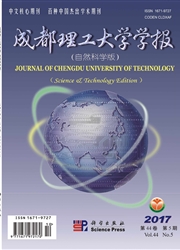

 中文摘要:
中文摘要:
热液白云岩具有特殊的形成机制,相关研究具有重要的理论意义和实用价值。四川盆地西部中二叠统栖霞组白云岩以原始结构不保存的结晶白云岩为主,形成于缺乏蒸发盐的地层中,普遍发育非平直晶面他形晶和鞍形晶等在相对高温环境中沉淀的白云石。113个不同结构白云石的包裹体均一化温度平均值为136℃,变化在平直晶面半自形晶的67℃到非平直晶面鞍形晶的243℃之间,主要温度区间为80~180℃。结构观察表明,白云化作用发生在埋藏深度只有数百米的浅埋藏环境,地热增温难以导致如此高的温度,与峨眉山玄武岩有关的热事件提供的热源造成的温度升高克服了低wMg/wCa比值条件下白云石沉淀的动力学屏障。在矿物组成上,栖霞组缺乏白云石质量分数在90%以上的碳酸盐岩,岩石中白云石的质量分数主要集中在40%~60%的范围内,说明白云化作用是一种不彻底的过程,这与峨眉山玄武岩热效应持续时间很短(257±3)~(263±5)Ma B.P.、难以使碳酸盐岩完全白云化有关。结构观察还表明,川西栖霞组白云岩普遍经历了溶解作用和破碎作用,以形成温度最高的非平直晶面鞍形晶白云石的溶解和破碎作用最为发育,由白云石溶解或破碎形成的孔洞缝中主要充填方解石。但这些方解石具有比其主晶白云石(尤其是鞍形白云石)低得多的包裹体均一化温度(主要分布在70~80℃之间),显示鞍形白云石沉淀后至少经历了70℃(最大值达150℃)的温度倒退。温度倒退的物理效应导致已沉淀白云石的破碎,化学效应则导致白云石的溶解和方解石的重新沉淀(去白云化作用),因而四川盆地西部栖霞组的白云化也是一种回头白云化作用。这种不彻底的和回头白云化作用形成了具特殊构造的豹斑状白云岩或灰岩(灰斑云岩或云斑灰岩)。
 英文摘要:
英文摘要:
The study of hydrothermal dolomite is significant theoretically and practically because of its particular mechanism. The Middle Permian Qixia dolomites in West Sichuan are essentially the fabric- destructive crystalline dolomites, including the non-planar anhedral and saddle dolomites that are related to the elevated precipitating temperatures. 113 fluid inclusions in different dolomite phases have an average homogenization temperature of 136 ℃, varying from 67 ℃ (planar subhedral dolomite) to 243℃ (non-planar saddle dolomite). Most of the temperatures cover the range between 80℃ and 180℃. The analysis of burial history indicates that the geotherm could not provide such a high temperature range. The related thermal event forming the gmeishan basalt developed in West Sichuan at 259 Ma B.P. (late middle Permian) and had the paleo-heat flow of 60 to 80 mW/m2 (higher than 100 mW/m2 for few drills), suggesting that the Qixia Formation in West Sichuan was influenced by the magmatism related to thermal effects during its shallow burial stage. Therefore, the hydrothermal process was the dominant dolomitizing mechanism in Qixia Formation of West Sichuan. The elevated temperature was caused by the extraneous thermal events, and overcame the kinetic obstacle for dolomite precipitations, especially under the conditions of low Mg/Ca ratios. The Qixia Formation in West Sichuan is mineralogically lack of carbonate rocks with dolomite content of more than 90%. And the dolomite content is essentially between 40 % and 60 % in rock samples, suggesting that the process of dolomitization was incomplete. The insufficiency of completely dolomitized bulks is the result of short duration of the related thermal event forming the Emeishan basalt (6 Ma, between 257±3 Ma B.P. and 263±5 Ma B. P. ) and of the shortage of magnesium ions in strata. Based on the textural observation, the dissolutions and fragmentations are commonly found in Qixia dolomites in West Sichuan, especially in the saddle dolomite. Most of
 同期刊论文项目
同期刊论文项目
 同项目期刊论文
同项目期刊论文
 Geochemical characteristics of the Permian Changxing Formation reef dolomites,northeastern Sichuan B
Geochemical characteristics of the Permian Changxing Formation reef dolomites,northeastern Sichuan B Oxygen and carbon isotopic composition in carbonate rocks of the Permian Qixia Formation, Sichuan Ba
Oxygen and carbon isotopic composition in carbonate rocks of the Permian Qixia Formation, Sichuan Ba The relationship between dolomite textures and their formation temperature: a case study from the Pe
The relationship between dolomite textures and their formation temperature: a case study from the Pe TSR-derived authigenic calcites in Triassic dolomite, NE Sichuan basin, China-A case study of well H
TSR-derived authigenic calcites in Triassic dolomite, NE Sichuan basin, China-A case study of well H 期刊信息
期刊信息
